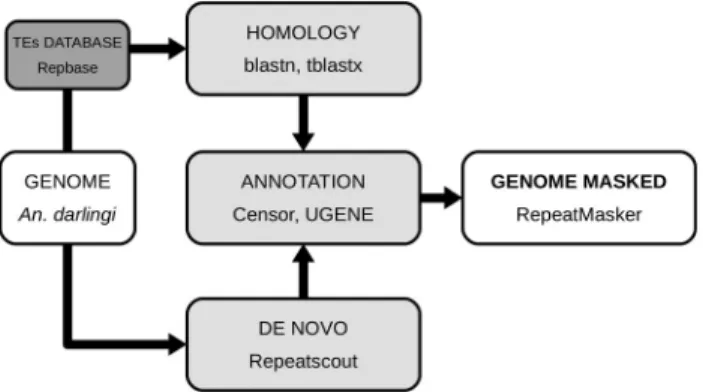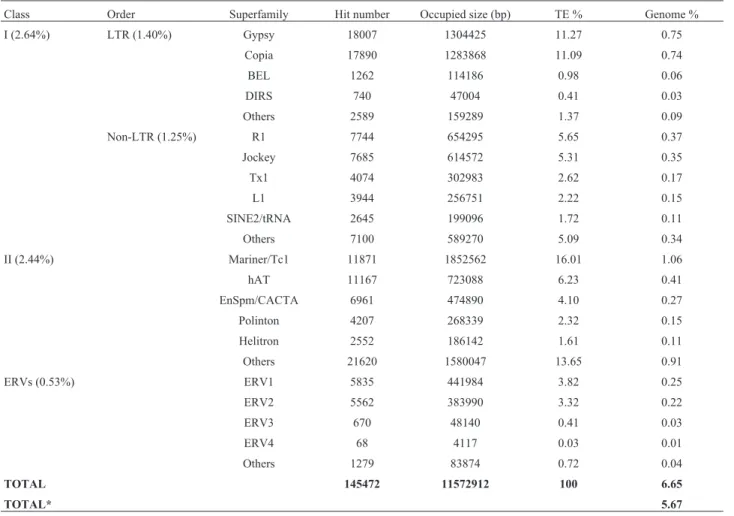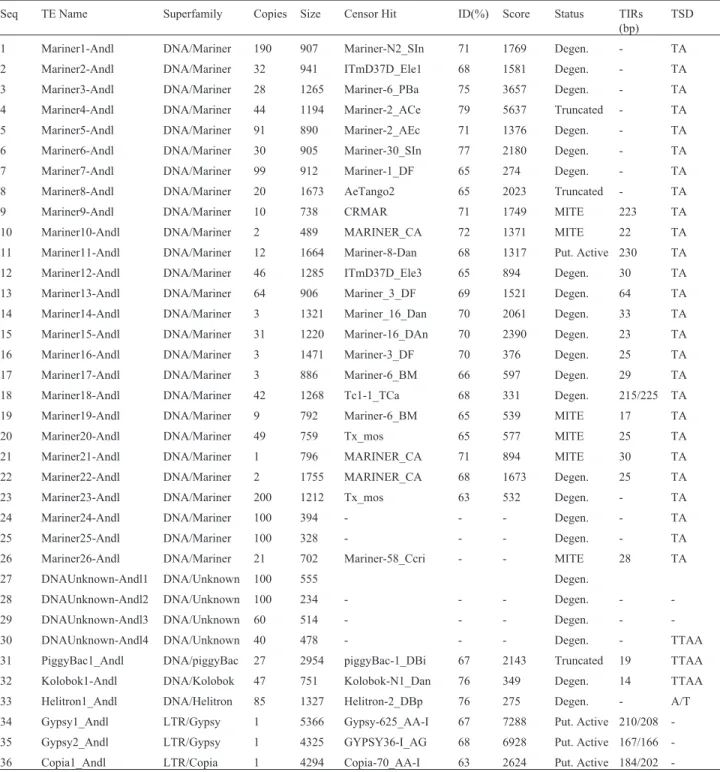A re-annotation of the
Anopheles darlingi
mobilome
Jose Francisco Diesel
1, Mauro F. Ortiz
2, Osvaldo Marinotti
3, Ana Tereza R. Vasconcelos
4and Elgion L. S.
Loreto
11
Departamento de Bioquímica e Biologia Molecular, Universidade Federal de Santa Maria, Santa Maria,
RS, Brazil.
2Programa de Pós-Graduação de Genética e Biologia Molecular, Universidade Federal do Rio Grande do
Sul, Porto Alegre, RS, Brazil.
3
Department of Molecular Biology and Biochemistry, University of California at Irvine, Irvine, CA, USA.
4Laboratório de Bioinformática do Laboratório Nacional de Computação Científica, Petrópolis, RJ, Brazil.
Abstract
The mobilome, portion of the genome composed of transposable elements (TEs), ofAnopheles darlingi was de-scribed together with the genome of this species. Here, this mobilome was revised using similarity andde novo search approaches. A total of 5.6% of theA. darlingi genome is derived of TEs. Class I gypsy and copia were the most abundant superfamilies, corresponding to 22.36% of the mobilome. Non-LTR elements of theR1 and Jockey superfamilies account for 11% of the TEs. Among Class II TEs, the mariner superfamily is the most abundant (16.01%). Approximately 87% of theA. darlingi mobilome consist of short, truncated and/or degenerated copies of TEs. Only three retrotransposons, two belonging togypsy and one to copia superfamilies, are putatively active ele-ments. Only one Class II element, belonging to themariner superfamily, is putatively active, having 12 copies in the genome. The TE landscape ofA. darlingi is formed primarily by degenerated elements and, therefore, somewhat sta-ble. Future applications of TE-based vectors for genetic transformation ofA. darlingi should take into consideration mariner and piggyBac transposons, because full length and putatively active copies of these elements are present in its genome.
Keywords: Transposable elements, transposons, mosquitoes, evolvability.
Received: September 19, 2017; Accepted: April 19, 2018.
Introduction
The mobilome is the complete set of mobile genetic elements in a genome. In eukaryotes, it is constituted mainly by transposable elements (TEs) (Siefert, 2009), comprising about 45% of the human genome, 20% ofD. melanogaster, and more than 50% of the maize genome (SanMiguelet al., 1996; Landeret al., 2001; Kaminkeret al., 2002). Transposable elements are drivers of evolution, as a source of genetic variability, generally by promoting chromosome rearrangements, mutations in the coding or regulatory regions of genes, domestication and epigenetic alterations (reviewed in Hua-Vanet al., 2011).
TEs are classified as autonomous elements when they are able to produce the enzymes necessary for their own mobilization, or as non-autonomous when they require en-zymes produced by related autonomous elements for that activity. TEs have also been classified into two classes,
namely RNA-mediated (Class-I) and DNA-mediated (Class-II) elements, according to their transposition mode. TEs often occur as remains or relics of old elements, which are not mobilizable any more. The combination of active, mobilizable, and remnants of TEs constitutes the TE land-scape of a genome, which is characteristic of a species. For example, in humans, the LINE-1/L1-element is the only el-ement that is presently active, while in Drosophila melanogaster30% of the TEs are full length and potentially active (Kaminkeret al., 2002). Closely related species can display distinct TE contents. For instance, TE contents vary from 2.7 to 23% among the genomes of 12Drosophila spe-cies (Clarket al., 2007), and amongAnophelesspecies it varies from 1.98 to 17.78% (Neafseyet al., 2015). Yet, a full, integral insight into the mobilome is not provided just by the proportion of a genome occupied by TEs and their classification. Also important is the identification of full length, putatively active elements. This aspect is particu-larly important for organisms that are potential candidates for genetic manipulation using transposon-based transgen-ic technologies. In these cases, the characterization of full Send correspondence to Elgion L. S. Loreto. Department of
Bio-chemistry and Molecular Biology, CCNE, Federal University of Santa Maria, Av. Roraima 1000, Camobi, 97105-900 Santa Maria, RS, Brazil. E-mail: elgion@base.ufsm.br.
length and active transposable elements is fundamental to estimate genomic stability and biosafety of the proposed products (Tereniuset al., 2008). In genetically transformed organisms, the presence of active endogenous TEs similar to the one(s) used in the transformation vector(s) might in-terfere with the efficiency of transgene integration and transgene stability due to cross mobilization (Arensburger
et al., 2011).
The classification and annotation of TEs is always a challenging task due to their remarkable diversity within and among genomes. TE copies recently inserted into a ge-nome show low sequence variability, though with time passing, copies accumulate mutations, deletions, and/or in-sertions, becoming decayed TE remnants (Hua-Vanet al., 2011; Hoenet al., 2015). Two main approaches are cur-rently used for TEs identification and annotation. Homo-logy-based methods search for sequences similar to known TEs compiled in databases. Thede novoapproach is based on the search for repetitiveness and structural signatures normally found in TEs (Hoenet al., 2015). New tools for mobilome scrutiny, exploration, and annotation warrant the re-analysis of previously described genomes (Kaminkeret al., 2002). Fernández-Medina et al. (2011) who re-analyzed the mobilome ofA. gambiae, found new TEs, de-scribed complete and potentially active elements, and char-acterized additional deleted, mutated, and probably inactive copies.
Anopheles darlingiis the principal Neotropical ma-laria vector, responsible for more than a million mama-laria cases per year (Oliveira-Ferreiraet al., 2010). The genome of this mosquito was sequenced, annotated, and its mobi-lome described (Marinottiet al., 2013). In that study, TEs were annotated applying a homology-based method, using a “home-made” TE database.De novosearch was used only to find MITEs and SINEs. In the present study, the Repbase database was used for a homology-based search, and the Repeatscout program was used forde novosearches. These improved approaches allowed us to advance our knowledge of theA. darlingimobilome, and to revise the number and annotation of the identified TEs in its genome.
Material and Methods
A. darlingitransposable elements were identified fol-lowing the pipeline shown in Figure 1. Blastn and tblastx (Altschulet al., 1997) were used to find similarities ofA. darlingi genome sequences (GenBank accession number ADMH02000000) (Marinottiet al., 2013) with the TEs ref-erences of the Repbase database (version 18.01) (Jurkaet al., 2005), considering e-values < 10e-10 as a cutoff to de-fine a Blast “hit”. Redundancies representing hits at over-lapping genomic positions, for different TEs, were considered as one hit for further analyses. Each target was expanded 5 kb on each side and searched for TIRs, LTR, TSD and conserved ORFs with the UGENE platform (Oko-nechnikovet al., 2012). The Censor software (Kohanyet
al., 2006) implemented with the Repbase database was used for the classification and annotation of TEs. Forde novosearches, Repeatscout version 1.0.0 software (Priceet al., 2005) was used. The obtained sequences were analyzed using UGENE to look for characteristics described previ-ously (TIRs, LTRs, etc.) and to classify these transposable elements. After obtaining a full library by similarities and
de novosearches, the genome was masked to determine the number of transposable elements using RepeatMasker (with-no_is -nolowoptions) (Smitet al., 2016). TEs were classified using Repbase (DNA, ERV, LTR, Non-LTR), and their number of copies and % of genome were calcu-lated.
Many short retrieved sequences show similarities with known TEs sequences. These short sequences are mentioned in the text as “hits” and classified as belonging to the superfamily corresponding to the best blast hit (low-est e-value). Sequences longer than 200 bp were manually curated with the UGENE platform for the annotation of ORFs, TIR, LTRs, and TSDs. All ORFs were analyzed by Blastp, and those showing similarities with TEs-encoded proteins were manually annotated. The sequences with typ-ical TE characteristics were designated as identifiable TEs (ITEs) and classified as: (1) complete elements - containing TIR (or LTRs) and complete ORFs; (2) degenerated – most often contain TIRs (or LTRs), however, the ORFs present mutations and deletions; (3) truncated - these elements show large deletions; (4) MITEs – short elements, having TIRs. When possible, sequences were assigned into fami-lies using Repbase; otherwise they were described as Un-known.
The repeat landscape of TEs found in theA. darlingi
genome was constructed with the full TE dataset obtained using the RepeatMasker tool.
Results
The TEs identified in this study correspond to 5.6% of theA. darlingigenome (Table 1). Class I elements corre-spond to 2.64% and Class II to 2.44% of the genome. For Class I, the superfamiliesgypsyand copiawere the most abundant. Together, these superfamilies account for 22.36% of all TEs. Non-LTR elements ofR1andJockey
superfamilies compound, together, 11% of all TEs. The
marinersuperfamily is the most abundant among the Class II elements (16.01%). Endogenous retroviruses (ERVs) correspond to 8.23% of the TEs.
A remarkable aspect of theA. darlingimobilome is that it is composed mainly of very short sequences display-ing significant similarities with TEs present in the used database. These hits are likely derived from extensively mutated and/or deleted TEs, lacking clearly identifiable TE structural features such as TIRs, LTRs, or TSD, etc.. The sequences containing identifiable TE structural features, ITEs, correspond to only 0.87% of theA. darlingigenome (Table 2). This value was obtained by multiplying the size of each element by copy number, which corresponds to 1.5 Mb. The entireA. darlingi genome was estimated to be
173.9 Mb (Marinottiet al., 2013). Thirty-six ITE elements were found, 26 belonging to themarinerfamily, one to the
piggyBacfamily, one tokolobokfamily, two elements are fromthe gypsyfamily, one from thecopiafamily, and four DNA/Unknown elements (Table 2). Short descriptions and sequences of each element are presented in List S1 of the Supplementary Material.
mariner elements are predominantly degenerated, and 17 elements were classified with this status. The copy number of these degeneratedmarinerelements range from 2 to 200 copies, and their sizes vary from 1755 to 889 bp. Sixmariner elements were classified as MITEs, ranging from 489 to 796 bp, and are represented by 1 to 49 copies. Two mariner elements were classified as truncated. One putatively activemarinerelement was identified. It is rep-resented by 12 copies in the genome, has a length of 1664 bp, and long TIRs with 230 bp.
Four degenerated elements were classified as DNA/Unknown because they have characteristics of class II elements, but their similarities with known TEs are not high enough for their classification into known families. The copy number of these elements is generally high,
rang-Table 1- Sequences showing significant hits with TEs identified inAnopheles darlingigenome.
Class Order Superfamily Hit number Occupied size (bp) TE % Genome % I (2.64%) LTR (1.40%) Gypsy 18007 1304425 11.27 0.75
Copia 17890 1283868 11.09 0.74
BEL 1262 114186 0.98 0.06
DIRS 740 47004 0.41 0.03
Others 2589 159289 1.37 0.09
Non-LTR (1.25%) R1 7744 654295 5.65 0.37
Jockey 7685 614572 5.31 0.35
Tx1 4074 302983 2.62 0.17
L1 3944 256751 2.22 0.15
SINE2/tRNA 2645 199096 1.72 0.11
Others 7100 589270 5.09 0.34
II (2.44%) Mariner/Tc1 11871 1852562 16.01 1.06
hAT 11167 723088 6.23 0.41
EnSpm/CACTA 6961 474890 4.10 0.27 Polinton 4207 268339 2.32 0.15 Helitron 2552 186142 1.61 0.11 Others 21620 1580047 13.65 0.91
ERVs (0.53%) ERV1 5835 441984 3.82 0.25
ERV2 5562 383990 3.32 0.22
ERV3 670 48140 0.41 0.03
ERV4 68 4117 0.03 0.01
Others 1279 83874 0.72 0.04
TOTAL 145472 11572912 100 6.65
TOTAL* 5.67
ing from 40 to more than 100 copies in the genome. Their sizes range from 234 to 555 bp, suggesting they are trun-cated elements.
A truncatedpiggyBacelement of 2954 bp with a 19 bp TIR was found, with a total of 27 copies. Degenerated
kolobokandhelitronelements were also found, with 47 and 85 copies, respectively.
Only three Class I putatively active ITEs were found. Two elements are from thegypsyfamily, having lengths of
5366 and 4325 bp, with LTRs of 210 and 167 bp, respec-tively. The third element, belonging to thecopiafamily, is 4294 bp in length and has LTRs with 184/202 bp. Only one copy of each of these retrotransposons was found in theA. darlingigenome.
Analysis of nucleotide divergence among the differ-ent copies of the found elemdiffer-ents allowed to depict a general landscape of the mobilome. The level of Kimura substitu-tion observed among the analyzed sequences is generally Table 2- Identifiable TEs found in theAn. darlingigenome.
Seq TE Name Superfamily Copies Size Censor Hit ID(%) Score Status TIRs (bp)
TSD
1 Mariner1-Andl DNA/Mariner 190 907 Mariner-N2_SIn 71 1769 Degen. - TA 2 Mariner2-Andl DNA/Mariner 32 941 ITmD37D_Ele1 68 1581 Degen. - TA 3 Mariner3-Andl DNA/Mariner 28 1265 Mariner-6_PBa 75 3657 Degen. - TA 4 Mariner4-Andl DNA/Mariner 44 1194 Mariner-2_ACe 79 5637 Truncated - TA 5 Mariner5-Andl DNA/Mariner 91 890 Mariner-2_AEc 71 1376 Degen. - TA 6 Mariner6-Andl DNA/Mariner 30 905 Mariner-30_SIn 77 2180 Degen. - TA 7 Mariner7-Andl DNA/Mariner 99 912 Mariner-1_DF 65 274 Degen. - TA 8 Mariner8-Andl DNA/Mariner 20 1673 AeTango2 65 2023 Truncated - TA 9 Mariner9-Andl DNA/Mariner 10 738 CRMAR 71 1749 MITE 223 TA 10 Mariner10-Andl DNA/Mariner 2 489 MARINER_CA 72 1371 MITE 22 TA 11 Mariner11-Andl DNA/Mariner 12 1664 Mariner-8-Dan 68 1317 Put. Active 230 TA 12 Mariner12-Andl DNA/Mariner 46 1285 ITmD37D_Ele3 65 894 Degen. 30 TA 13 Mariner13-Andl DNA/Mariner 64 906 Mariner_3_DF 69 1521 Degen. 64 TA 14 Mariner14-Andl DNA/Mariner 3 1321 Mariner_16_Dan 70 2061 Degen. 33 TA 15 Mariner15-Andl DNA/Mariner 31 1220 Mariner-16_DAn 70 2390 Degen. 23 TA 16 Mariner16-Andl DNA/Mariner 3 1471 Mariner-3_DF 70 376 Degen. 25 TA 17 Mariner17-Andl DNA/Mariner 3 886 Mariner-6_BM 66 597 Degen. 29 TA 18 Mariner18-Andl DNA/Mariner 42 1268 Tc1-1_TCa 68 331 Degen. 215/225 TA 19 Mariner19-Andl DNA/Mariner 9 792 Mariner-6_BM 65 539 MITE 17 TA 20 Mariner20-Andl DNA/Mariner 49 759 Tx_mos 65 577 MITE 25 TA 21 Mariner21-Andl DNA/Mariner 1 796 MARINER_CA 71 894 MITE 30 TA 22 Mariner22-Andl DNA/Mariner 2 1755 MARINER_CA 68 1673 Degen. 25 TA 23 Mariner23-Andl DNA/Mariner 200 1212 Tx_mos 63 532 Degen. - TA 24 Mariner24-Andl DNA/Mariner 100 394 - - - Degen. - TA 25 Mariner25-Andl DNA/Mariner 100 328 - - - Degen. - TA 26 Mariner26-Andl DNA/Mariner 21 702 Mariner-58_Ccri - - MITE 28 TA 27 DNAUnknown-Andl1 DNA/Unknown 100 555 Degen.
-high (Figure 2). Few copies of the elements are well con-served, indicating that only few elements are active or have been recently mobilized or duplicated. So the mobilome of
A. darlingiis constituted mainly of remains of degraded and ancient elements. In comparison, the proportion of cop-ies showing high similaritcop-ies is greater inA. gambiaethan inA. darlingi(Figure 2), suggesting the presence of active or more recently mobilized elements inA. gambiae.
Discussion
The results of this study show that a higher proportion of theA. darlingigenome (5.61%) is occupied by TEs than the previously reported 2.29% (Marinottiet al., 2013). For other organisms, re-analyses of mobilomes using updated tools and databases also resulted in distinct results. For ex-ample, the genomes ofDrosophilaspecies andA. gambiae
have been re-analyzed resulting in improved descriptions of their mobilomes (Kaminker et al., 2002;
Fernández-Medinaet al., 2011, Neafseyet al., 2015). Neafseyet al.
(2015) compared the genomes of 16Anophelesspecies and found thatA. albimanuswas the mosquito with the genome occupied by the lowest proportion of TEs (1.98%), fol-lowed byA. cristyi(2.81%). The Anopheline species with the highest content of TEs in its genome is A. gambiae
(17.78%). The authors also reported a direct correlation be-tween genome size and TE content, with species showing smaller genomes tending to have lower TE contents. Simi-lar correlations between genome size and TE content have also been found for other taxa (Sessegoloet al., 2016). The genome size ofA. darlingiis among the smallest among the sequencedAnophelesspecies, and similar to those found in
A. albimanusandA. cristyi[»180 Mb] (Table S1). While the TE content found in those species is around 2%, our re-analyses increased the A. darlingi TE content from 2.29% to 5.61%, a value comparable to those of Anophe-line mosquitoes with larger genome sizes (» 220 Mb). However, the direct correlation between TE content and ge-nome size has outliers. For example, although A. quadriannulatusandA. gambiaehave genomes with simi-lar sizes, the TE content of the former is less than half of that of the latter (Neafseyet al., 2015, see also Table S1). Although there is variation, in Anopheline mosquitoes, Class I TEs are generally more abundant then those of Class II, as observed also in the present analysis forAn. darlingi
(Table S2).
The increasedA. darlingiTE content reported in this study, compared to the previous description (Marinottiet al., 2013; Neafseyet al., 2015) is the result of an approach that utilized improved tools and databases. The database used for homology searches in the present study is larger than the one applied in the previous analysis. Also, it is due to the inclusion, in the present report, of short fragments de-rived from degenerated TEs. The overall proportional rep-resentations of the different TE superfamilies inA. darlingi
were maintained between the present and previous analyses (Marinottiet al., 2013), withgypsy as the most abundant LTR element andmarinerelements as the most abundant ones among the DNA transposons. However, some differ-ences were seen for other superfamilies. For example,
copiawas the second most abundant superfamily observed in this study, but only 0.9% ofcopiaelements were regis-tered in the Marinottiet al.(2013) study.
Active or mobilizable elements are associated with evolvability of species and their capacity to environmental adaptation (Fablet and Vieira, 2011; Casacuberta and Gon-zález, 2013). The TE landscape ofA. darlingiis predomi-nantly formed by degenerated elements, contrasting with species such as A. gambiaeand D. melanogaster, which harbor a larger number of potentially active elements. In
Drosophila melanogaster,80% of spontaneous mutations are promoted by TE mobilizations, making it an important source of genetic variability (García Guerreiro, 2012). In contrast, only four putatively active elements were found in Figure 2- Comparison of TE landscapes ofA. darlingi (A) andA.
the assembledA. darlingigenome. It is also remarkable that the copy number found for putative active retrotransposon is very low; only one copy of each element has been identi-fied. Only the putative active mariner element (Mariner11-Andl) has a higher copy number (12 copies). Judging from this landscape structure, the genome ofA. darlingiis likely to be stable. Few TEs are capable of, or prone to respond to environmental stressors and likely to promote an increase in mutability.
As a recommendation for future uses of transposable elements as vectors for genetic transformation of A. darlingi, attention should be given to the use ofmariner el-ements, as it was the only putatively active DNA TE found in the sequenced genome.piggyBacelements also deserve certain attention, because a truncated element is present in the genome. The use of other Class II transposable elements is suggested as being safer, as functional elements are not present to promote cross mobilization.
In conclusion, the mobilome ofA. darlingiis primar-ily occupied by degenerated elements, showing a minute number of active elements with small copy number, charac-teristic of a genome that is rather stable.
Acknowledgments
This study was supported by research grants and fel-lowships from CNPq (Conselho Nacional de Desenvol-vimento Científico e Tecnológico).
Conflict of Intererest
The authors have declared that no competing interests exist.
Author contributions
ELSL, MFO, ATRV and OM conceived and designed the study; JFD and MFO conducted the bioinformatics analysis; ELSL, JDD, MFO, ATRV and OM wrote the manuscript. All authors read and approved the final ver-sion.
References
Altschul SF, Madden TL, Schäffer AA, Zhang J, Zhang Z, Miller W and Lipman DJ (1997) Gapped BLAST and PSI-BLAST: A new generation of protein database search programs. Nu-cleic Acids Res 25:3389-3402.
Arensburger P, Hice RH, Wright JA, Craig NL and Atkinson PW (2011) The mosquitoAedes aegyptihas a large genome size and high transposable element load but contains a low pro-portion of transposon-specific piRNAs. BMC Genomics 12:606.
Casacuberta E and González J (2013) The impact of transposable elements in environmental adaptation. Mol Ecol 22:1503-1517.
Clark AG, Eisen MB, Smith DR, Bergman CM, Oliver B, Mar-kow TA, Kaufman T, Kellis M, Gelbart W, Iye VNet al.
(2007) Evolution of genes and genomes on the Drosophila phylogeny. Nature 450:203-218.
Fablet M and Vieira C (2011) Evolvability, epigenetics and trans-posable elements. BioMol Concepts 2:333-341.
Fernández-Medina RD, Struchiner CJ and Ribeiro JM (2011) Novel transposable elements from Anopheles gambiae. BMC Genomics 12:260.
García-Guerreiro MP (2012) What makes transposable elements move in the Drosophila genome? Heredity 108:461-468. Hoen DR, Hickey G, Bourque G, Casacuberta J, Cordaux R,
Feschotte C, Fiston-Lavier AS, Hua-Van A, Hubley R and Kapusta A et al. (2015) A call for benchmarking trans-posable element annotation methods. Mobile DNA 6:13. Hua-Van A, Le Rouzic A, Boutin TS, Fillee J and Capy P (2011)
The struggle for life of the genome’s selfish architects. Biol Direct 6:19.
Jurka J, Kapitonov VV, Pavlicek A, Klonowski P, Kohany O and Wali-Chiewicz J (2005) Repbase update, a database of euka-ryotic repetitive elements. Cytogenet Genome Res 110:462–467.
Kaminker JS, Bergman CM, Kronmiller B, Carlson J, Svirskas R, Patel S, Frise E, Wheeler DA, Lewis SE, Rubin GMet al.
(2002) The transposable elements of the Drosophila melanogaster euchromatin: A genomics perspective. Ge-nome Biol 3:1-20.
Kohany O, Gentles AJ, Hankus L and Jurka J (2006) Annotation, submission and screening of repetitive elements in Repbase: RepbaseSubmitter and Censor. BMC Bioinformatics 25:474.
Lander ES, Linton LM, Birren B, Nusbaum C, Zody MC, Baldwin J, Devon K, Dewar K, Doyle M, FitzHugh Wet al.(2001) Initial sequencing and analysis of the human genome. Na-ture. 409:860-921.
Marinotti O, Cerqueira GC, de Almeida LG, Ferro MI, Loreto EL, Zaha A, Teixeira SM, Wespiser AR, Almeida E, Silva Aet al.(2013) The genome ofAnopheles darlingi, the main Neo-tropical malaria vector. Nucleic Acids Research 41:7387-7400.
Neafsey DE, Waterhouse RM, Abai MR, Aganezov SS, Ale-kseyev MA, Allen JE, Amon J, Arcá B, Arensburger P, Artemov Get al.(2015) Mosquito genomics. Highly evol-vable malaria vectors: The genomes of 16 Anopheles mos-quitoes. Science 347:1258522.
Okonechnikov K, Golosova O and Fursov M (2012) The UGENE team. Unipro UGENE: A unified bioinformatics toolkit. Bioinformatics 28:1166-1167.
Oliveira-Ferreira J, Lacerda MV, Brasil P, Ladislau JL, Tauil PL and Daniel-Ribeiro CT (2010) Malaria in Brazil: An over-view. Malar J 9:115.
Price AL, Jones NC and Pevzner PA (2005)De novo identifica-tion of repeat families in large genomes. Bioinformatics Suppl 1:i351-8.
SanMiguel P, Tikhonov A, Jin YK, Motchoulskaia N, Zakharov D, Melake-Berhan A, Springer PS, EdwardsKJ, Lee M, Avramova Zet al.(1996) Nested retrotransposons in the intergenic regions of the maize genome. Science 274:765-768.
Siefert JL (2009) Defining the mobilome. Methods Mol Biol 532:13-27.
Smit AFA, Hubley R and Green P (2016) RepeatMasker Open-4.0, http://www.repeatmasker.org.
Terenius O, Marinotti O, Sieglaff D and James AA (2008) Molec-ular genetic manipulation of vector mosquitoes. Cell Host Microbe 4:418- 423.
Supplementary material
The following online material is available for this article:
Table S1 – Comparison of genome size and TE contents in
Anophelesgenus.
Table S2 – Percentage of genome occupied by main TEs superfamilies inAnophelesgenus.
List S1 – Description of 36 Identifiable TEs found in the
Anopheles darlingigenome.
Associate Editor: Carlos F.M. Menck



